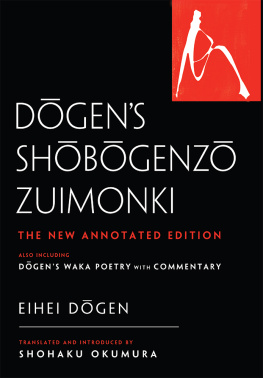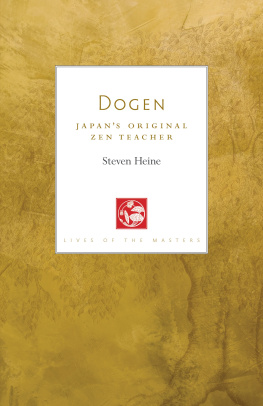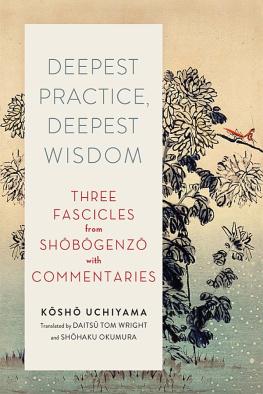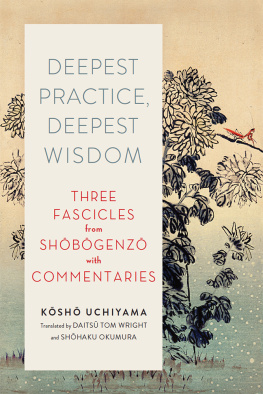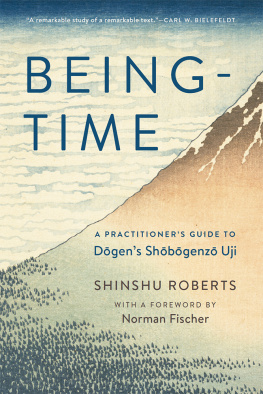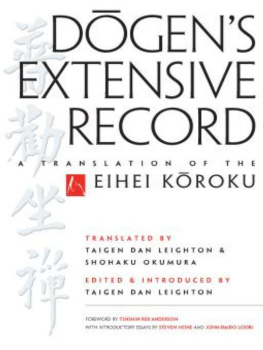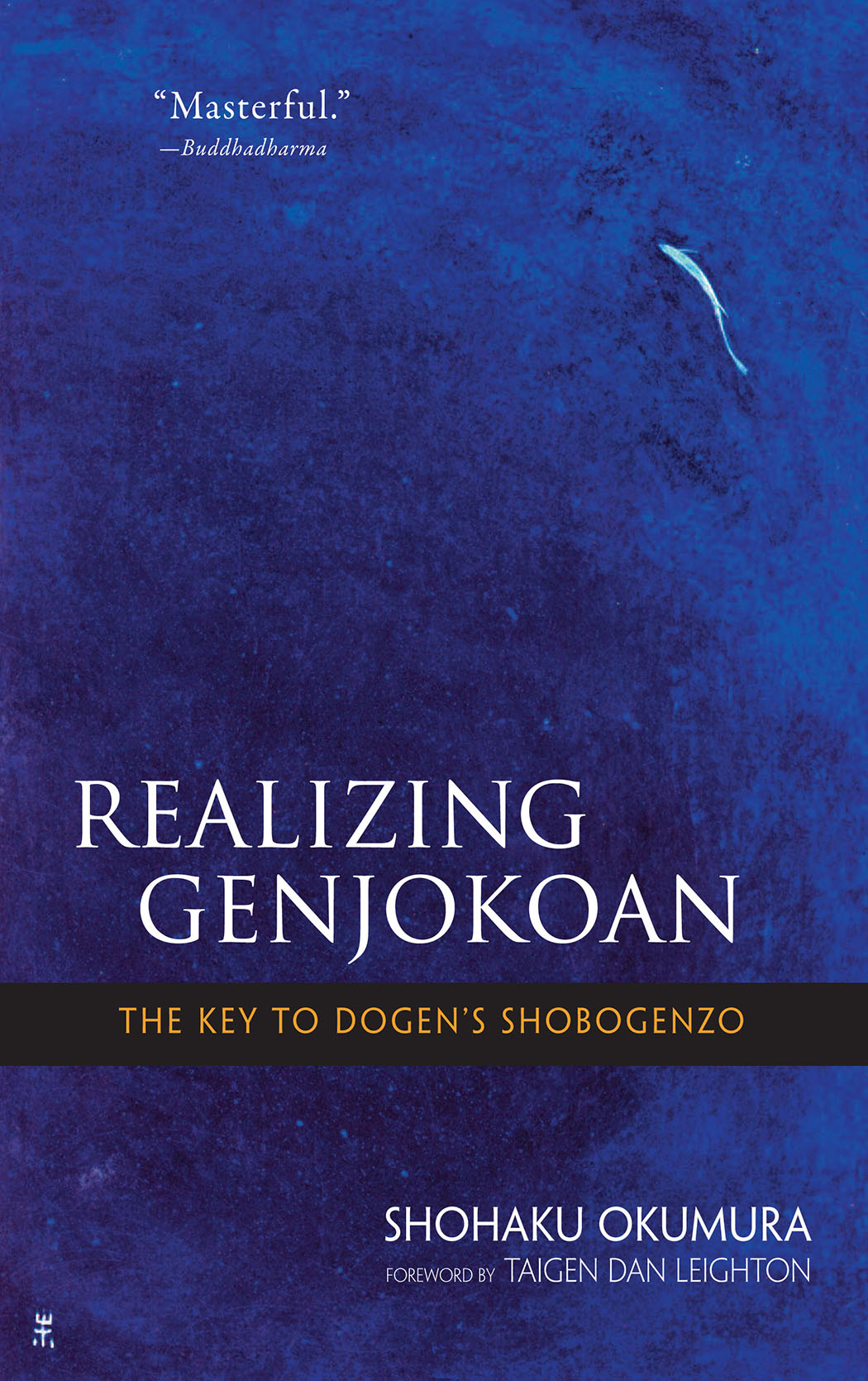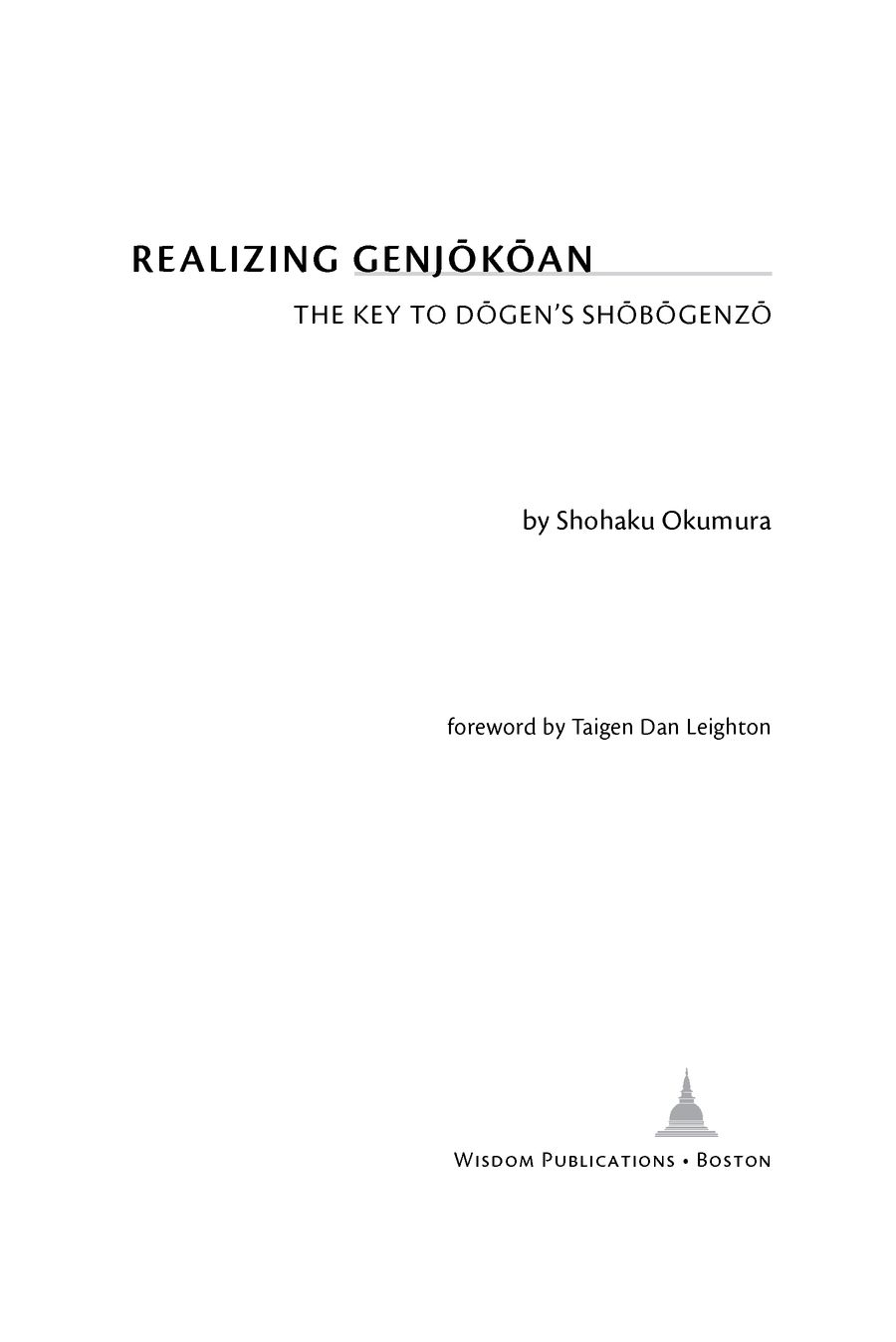Table of Contents
FOREWORD
THIS BOOK is a treasure. Shohaku Okumura has given us a work of great value for any student of Eihei Dgens teachings, for Zen practitioners, or for anyone interested in learning about Zen. The writings and teachings of the thirteenth-century Japanese St lineage founder Eihei Dgen have been highly influential not only in the introduction of Zen to the West, but for Western interest in all of Buddhism. And of all Dgens profuse writings, none has likely been more frequently cited or more illuminating than this essay, Genjkan. Even though it was written originally as a letter to a lay practitioner, as is common for Dgens writings it is also highly dense and profound, and its subtleties of meaning are far from obvious. An old Zen slogan denigrates dependence on words and letters, instead emphasizing direct pointing to mind and awareness. So it is ironic that Zen has produced extensive libraries of writings, often composed of commentaries on previous writings like this one. But the point of such writing, as Dgen specifically delineates in some of his essays, is the encouragement and refining of practice, rather than propounding theoretical philosophical positions. Genjkan is such a text, clarifying and supporting the actual unfolding practice of awakening. This extended and engaging commentary by Shohaku Okumura further reveals and supports the practical application of Dgens teaching, making it a great service both to new students as well as to those long familiar with Genjkan.
For new students of Zen meditation, many passages herein will be very helpful for finding the inner rhythm of Zen meditation and practice generally. For example, in chapter 5, Realization beyond Realization, one finds varied useful accounts of how we create and are impacted by our mental maps of the world, the process of delusion that Dgen clearly but subtly defines in Genjkan. Shohaku says, Within this mental map there are things we think are good, useful, or valuable, such as flowers, and there are other things we think are bad, useless, or worthless, such as weeds. Usually we take it for granted that the fabricated picture of the world in our minds is the world itself. Our attachment to flowers and dislike of weeds is one of Dgens early images in Genjkan. The process of zazen helps us see through our usual graspings and rejections, and the resulting mischief in our lives. Shohaku provides practical elaboration. For example,
The practice of zazen can help us understand that our pictures of the world and our values are biased and incomplete, and this understanding allows us to be flexible. Being flexible means that we can listen to others opinions knowing that their biases are simply different from ours, according to the circumstances and conditions of their individual lives. When we practice in this way our view broadens and we become better at working in harmony with others. By continually studying the nature of reality, of the Dharma in its universal sense, and by awakening to our biases, we keep working to correct our distorted views. This is how letting go of thought in zazen informs practice in our daily lives.
Shohaku also clarifies the practical relevance of the study of the self and the dropping off of the body and mind of the self, which is described and encouraged by Dgen in Genjkan. In clear language Shohaku expresses his own letting go of self-identification in zazen as taking off the clothes of identity to reveal our naked being.
We wear the clothing of occupations such as doctor, lawyer, mechanic, priest, student, teacher. But when we sit facing the wall and let go of thought, including comparing ourselves with others, we take off all this clothing. In zazen I am not a Japanese Buddhist priest; I am neither Japanese nor American. In zazen we are neither rich nor poor, neither Buddhist nor Christian. The terms Japanese, American, Buddhist, Christian, man, and woman are only relevant when we compare ourselves with others. When I compare myself with Americans, I am Japanese, but before I knew of people who werent Japanese I didnt know that I was Japanese. When we just sit facing the wall in zazen, we are neither deluded living beings nor enlightened buddhas; we are neither alive nor dead; we are just as we are. Thats it. In zazen we take off all of our clothing and become the naked self.
Shohaku also shows how primary Buddhist teachings are embedded in the first paragraph of the Genjkan text, demonstrating that Zen and Dgens teaching are firmly rooted in the Buddhas teaching and the developments of Mahayana Buddhist philosophy. Shohaku interprets the first sentence in terms of some of Shakyamuni Buddhas basic teachings such as the four noble truths and the twelve links of causation. The second sentence, ... without [fixed] self, there is no delusion and no realization, no buddhas and no living beings, no birth and no death is presented with extended commentaries on Madhyamika emptiness teaching, the Yogacara study of consciousness, as well as the Tathagata-garbha Buddha-womb branch of Mahayana thought. These are all expressed and compared in terms of the Heart Sutra, which is provided in Shohakus translation in an epilogue. The third sentence, Since the Buddha Way by nature goes beyond [the dichotomy of] abundance and deficiency, there is arising and perishing, delusion and realization, living beings and buddhas, Shohaku presents as Dgens own teaching, echoing Dgens commentary on the Heart Sutra, Maka Hannya Haramitsu, also provided in Shohakus translation in the epilogue. While providing this introduction to Buddhist teachings generally, Shohakus discussions of Genjkan lead to comparisons with selections from many other writings of Dgen, presented with Shohakus translations and illuminating commentaries.
This book will be informative to new students of Zen and Dgen, but it will also be helpful for the many Western Zen people who have long studied Genjkan. Many quite useful translations of this essay are already available, as well as helpful commentaries, but this book goes beyond. I have been considering Genjkan for thirty-five years, and still I enjoyed many helpful revelations in this book.
One example is that the fourth Chinese character or kanji used by Dgen for the word Genjkan, the an of kan, differs slightly from the character more commonly used for the familiar term kan, the encounter dialogue teaching stories, famous in Zen history and anthologized with extensive commentaries. Shohaku carefully analyzes the many fascinating implications of this different character used by Dgen. These interpretations are supported by the important commentary of Dgens close disciple Senne, and include the nuances from using the hand radical, with meanings related to healing, as well as the variant characters meaning of caring for ones uniqueness or particularity. Thus the term Genjkan has connotations including the manifesting of the interaction of unity and uniqueness.
Perhaps the most renowned statement in all of Dgens writings is the Genjkan line, To study the Buddha Way is to study the self. This kanji for study can mean, to become intimate with. Shohaku further analyzes the meaning here in terms of this Chinese characters combining self and wings of a bird, so that this study of the self advocated by Dgen Shohaku likens to a baby bird learning to fly. The ensuing discussion is informative and colorful, including Shohakus example for such study of using our interaction with a car as we drive. Shohakus explications of the overtones of the kanji for study are highly suggestive. As Dgen follows the above line with, To study the self is to forget the self, we might view this self with bird wings as the self flying away, or perhaps the deeper self taking flight to be verified by all things and let body and mind of the self and of others drop off, as Dgen then adds.



